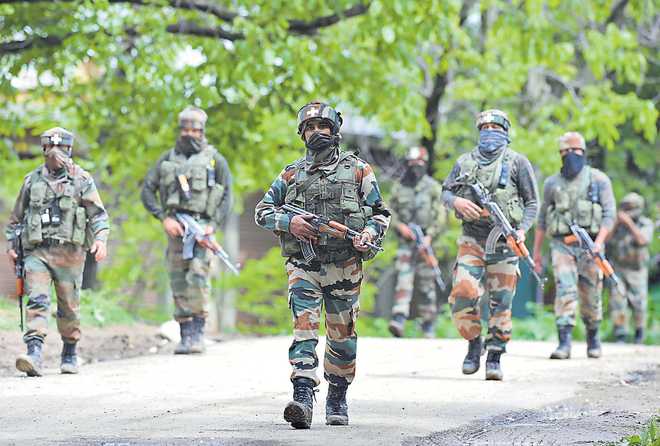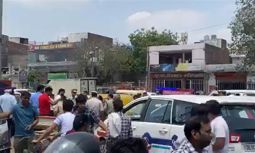
REAPING DIVIDENDS?: Soldiers fan out during an operation against suspected rebels in Shopian sector, south of Srinagar on May 4, 2017.
Lt Gen Syed Ata Hasnain (retd)
IT is not often that you will find analyses of individual operations of the security forces in the media. However, when you witness a revisit to tactics of the past, those done away 17 years ago, perhaps such a review may be pertinent. Technology has enabled the spread of diverse information in the intervening period that the degree of interest in the public on such issues has multiplied manifold. In the backdrop of the heinous act by the Pak Army-terrorist combine in Poonch on April 30, 2017 military operations on the LoC also occupy greater space.
When the Army moved two brigades from Udhampur into Kashmir in August-September 2016 in the wake of large-scale disturbances which had paralysed governance, one knew it was a dire requirement. No military institution ever teaches how such large forces are to be employed in classic hybrid situations to restore order. All that was needed with these forces was the occupation of the space in South Kashmir which had been vacated over time to plug infiltration at the LoC. It was important to back up the JK Police to reoccupy the vacated police stations, bolster the confidence of the force which had been targeted in a much focused way and regain/re-establish the "moral ascendancy" of the Army which may have diluted. The Army did it that way, ensuring it sent a "strong message" of its presence and that it would not resort to any wrong means to control the situation, even in the face of serious provocation which was underway.
Those brigades have probably withdrawn and the situation in South Kashmir has worsened in many ways in 2017. In my years with Victor Force of the Rashtriya Rifles (RR), I always considered the quadrilateral formed by Bijbehara, Kulgam, Shopian and Pulwama (see map) as the citadel which needed to be breached. That is the very area causing much concern today although Central Kashmir has also witnessed the same. The recent incidents of bank robberies and the ambush on the cash van of the J&K Bank, leading to the killing of five JK policemen (all from Kashmir) and two local bank security men cannot be glossed over. The message is there is no remorse in the killing of locals if they stand in the way. No doubt, Kashmiris have lost their lives at the altar of local terrorist actions in the past and even targeted killings have taken place but a lack of condemnation and an expression of happiness by locals is disturbing. This is a reversal of much that had been gained. It signifies the stronger entry of Pakistani terror groups and influences without which such a trend would seldom be witnessed. In the past, Pakistani terror groups have announced their domination through some heinous acts such as minority killings and massacres of innocents. It is something the security set-up in Kashmir should be wary of.
Thus Operation Clean Up launched on 4 May hasn't come anytime too soon. It's a joint operation of the Army's RR, CRPF and the JK Police. In purely military operational terms, it is aimed at regaining control that may be perceived to be in contention, not necessarily lost. The last time large formation sized search and destroy operations (SADO) or cordon-and-search operations (CASO) were conducted was in 1999-2000. In the Hafruda forest belt jungle searches have been a norm even in recent years. The Army's strategic reserve was in the Valley as a follow-up to Kargil and was employed both for “jungle bashing” and search of semi-urban areas. It had its effect, sending home the resolve of the state. While many recoveries of logistics material of terror groups were made, the ensuing effect was the killing of terrorists who did not have the sustenance to survive in their hideouts. More importantly, the psychological message was sent that the Army would always resort to any type of operations to ensure its operational and tactical domination. Since then the Army has calibrated its concept of operations restricting these to intelligence-based ones or small CASOs so as not to cause unnecessary inconvenience to the public. This was progressive revision of concepts. Conflict progression moved towards conflict stabilisation and was in sync with the political initiatives of Prime Minister Atal Behari Vajpayee and Chief Minister Mufti Mohammad Sayeed. Hybrid war situations like all military situations are always dynamic; no use of bemoaning lost opportunities. They will always return and perhaps one may be better prepared for them then.
What should be expected from Operation Clean Up? Is the return to tactics of yore worth it, especially since not much seems to have been achieved in terms of apprehensions, neutralised terrorists or recovery of warlike stores?
General Bipin Rawat, the Army Chief has invested a lot in the current operation, having personally visited HQ 15 Corps to take stock of plans and give last-minute directions. These operations usually commence late at night, with cordons being established. The population is asked to vacate houses early morning and then search is carried out. The difference from the “crackdowns” of the 1990s is the large-scale presence of the media in all these villages and townships. Clearly, the operation was not pushed to limits as stone-throwing emanated and the security forces did not use coercive power, their intent being focused on the terrorist element.
The operation appears only a demonstration of intent and not more.There will be difference of opinion on whether more coercion should have been used against stone-throwers and their leaders. Obviously, this is being carefully calibrated. Two things are important if the messaging has to be correct. The information domain needs as much domination as the physical space of South Kashmir. The negativism against India at the recent UN Human Rights Review Meet proves how far we are from effectively projecting India's stance.
Second, return to old tactics in a calibrated way for a necessary reason is fully justifiable as street and terrorist violence was spiralling out of control. What must accompany this is an engagement not of separatists or their cohorts but a set of people who believe in India. As stabilisation of the security situation begins, the India supporters can be strengthened.
It must also be continuously demonstrated that Kashmir has distinct advantages by being part of India. Soft power can never be divorced from hard power in workable strategies; only one has to know where and in what quantum soft power must be applied.
Demonstration of intent must be as focused as much as the hinterland. The best psychological message at the LoC is always evident when commanders on the ground have the freedom to act. Under the circumstances there should be complete empowerment, subject to fitment into overall strategy.
The writer, a former GOC of the Srinagar-based 15 Corps, is now associated with the Vivekanand International Foundation.



























